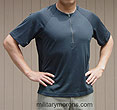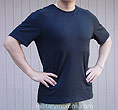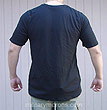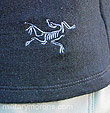Light Weight Base Layers Page 1, 2
This section features 'Next to skin' garments
As a sizing reference: I'm 5'7", 155 lbs (yeah, I'm a little guy), medium build (BDU top medium/regular, BDU pant medium/short), waist 32", chest 43". Keep this in mind when you read my comments with respect to sizing, so you have an idea of how the garments featured below will fit on you. ALL garments in these pages are size Medium, unless stated otherwise.
TO VIEW FULL SIZE IMAGES: USERNAME and PASSWORD are both "mm"
| Military Clothing Systems Over the past decade, we've finally been seeing the
military take notice and adopt some of the advanced technology/high
performance fabrics and clothing that civilian mountaineers and backpackers
have been using for quite a while. Lighter, more compressible, breathable,
quick drying and wicking fabrics now clothe the soldier, doing their
part to make a tough job a bit more efficient and a bit less uncomfortable.
Clothing the soldier presents a unique challenge as temperatures in
certain regions may range greatly over a 24 hour period, or missions
might start off at low altitudes and end up much higher. Soldiers
most often have to be self-sufficient, carrying everything in their
rucks and on their person, so light weight and clothing versatility
rank high in importance. Unlike most sporting events, the soldier
might have to wear the same clothing for days or weeks on end, and
subject them to abuse that civilian use won't.
Typically, there can be several different manufacturers/contractors making the same garments. Sometimes different manufacturers make different levels in the same program, and I hope to feature more of them here. I'm also learning that the item of the same name might vary by manufacturer with differences in materials and features. I was surprised to find this out, and expected the garments to be more standardized. |
|
NS21 PCU Level 1 Lightweight
Pant (below) -
The Level 1 lightweight pant is constructed of Polartec® Power
Dry® fabric with X-STATIC® in coyote brown. Intended to
be worn next-to-skin as a base layer, the fabric is a wicking material,
designed to keep your skin dry when you sweat. It's a bi-component
knit that uses different yarns on either side of the fabric. Look
at the photos above and you can see the inner surface which is optimized
to move moisture away from the skin, and the outer surface, for fast
drying. X-STATIC® inhibits the growth of odor-causing bacteria
in the fabric, and incorporates pure silver-bonded fiber that is permanantly
knit into the fabric construction and will last as long as the fabric
does.
|
|
PCU Level 1 T-shirt and
Boxer- The Level 1 Silkweight T-shirt and boxer are
constructed of smooth Polartec® Power
Dry® fabric. Designed to keep your skin dry when you perspire,
the stretch material has a smooth texture that feels very soft next
to the skin. Depending on the light, the material (and most of these
other PCU materials) can look "bronzine/gray-green" (as
described on the SEKRI website) under fluorescent lights to a coyote-ish
brown under natural and incandescent lighting. The medium size T-shirt
was a perfect fit for me and cut very comfortably - no binding or
restrictions; neither too tight nor loose. It's cut longer in the
back than in the front, which seems to be common feature amongst the
PCU garments.
PCU Level 1 Long Sleeve
Shirt and Pant- Also meant to be worn next-to-skin,
the Level 1 Long Sleeve Shirt and Pant are made of the same Polartec®
Power
Dry® fabric with X-STATIC® I've already covered in the
Insport review above. Rather than the silky fabric of the T-shrt and
Boxer, it has minute holes in the outside surface that aids in evaporation
of moisture. A 12" zip in the front closes the 2.5" high
collar. Also cut longer in the back, it'll stay tucked in.
3/23/05 - Wore the Level 1 long sleeved shirt and Level 2 Long sleeve shirt on a short hike. Temperature went from about 62° to 57°. Pretty strong, cool breeze. I was comfortable-warm with both on, and on the way back, when I started working up a sweat, I had to remove the Level 2 as it got too warm. The Level 1 kept me comfortable on the move despite the breeze and dropping temp. |
|
Adventure Tech's APCU (Advanced Protective Combat Uniform) mirrors the PCU (Protective Combat Uniform) system with the seven garment layers. The Adventure Tech APCU Level I - SS (Short-Sleeved) Lightweight Baselayer Top (available from USCAV) is a stretchy, Level I base layer shirt with breathable panels and X-Static silver fiber. Material - The APCU Level 1 Light Weight shirt is made of a synthetic stretch fabric with 'activated Carbon-Tech with 5% X-Static silver lining'. The activated carbon embedded within the Carbon baselayer fiber is supposed to improve the perspiration process by pulling moisture away from the skin to bring it to the fabric surface for evaporation. The X-Static silver is anti-odour, anti-static and anti-microbial. The APCU L1 shirt also provides Ultraviolet Protection up to UPF 50+ and is designed to be the worn next-to-skin as the first layer in the system.
General Description - The APCU L1 shirt comes in Coyote, Alpha Green (shown here - it's actually grey) and Black. There are seamless, super-breathable panels woven into the center of the back and under the arms, extending down the sides. This is part of the 'body mapping' technology along with no seams on top of the shoulders to reduce hot spots. All seams are flat for comfort. Observations - When I first got the APCU L1 shirt,
the material didn't feel as soft as I had anticipated it would.
It's not a silky soft fabric like the Zensah shirts, but textured
a bit more like the Insport base layers I have. The plus side is
that it's not as snaggy on hook velcro as the Zensah and feels more
durable. The APCU L1 shirt is pretty long. Well, I have a short torso, actually. Even so, it extends almost all the way down to my hands - more like a 'medium long' fit than a 'medium'. I think the bottom hem can be shortened by about 2-3" with still plenty of length left to tuck it in. It doesn't need to extend to my crotch or below my buttocks. It stretches - it's not going to become untucked when you bend over. The fit on me is tight around the arms, more relaxed around the torso, and a bit loose at the collar. So, it's not really a compression shirt - only in the arms (and I don't have big arms). I'd rather it fit consistently over my whole body - either all tight or all relaxed. That's just all personal preference, though. The sleeves are also a bit longer than normal, which I like. If they're too short, they tend to ride up my arms and bunch up under the armpit. For me, the APCU shirt sleeves are the perfect length. I used this shirt for running/jogging, which is when I sweat the
most. The way synthetic 'wicking' shirts work is to get soaked with
sweat (which means it's drawing sweat off your body), then evaporating
that sweat as it dries. While synthetic shirts may not get soaked
as quickly as natural fibers (it takes a while for the capillary
action to work), they dry much faster, and stay lighter and feeling
drier while doing so. As far as performance, the APCU shirt did
very well. I was sweating profusely and the APCU shirt was able
to soak it up, and yet remain feeling relatively dry to the touch.
To me, that means that sweat was being evaporated from it quickly.
Once I stopped running, it got soaked with my sweat more, since
I was no longer moving through the air, but still dried very quickly.
If I was wearing a cotton T-shirt, I'd be soaked in my own sweat
for a while. In summary, the APCU shirt performs well and dries very quickly. While I would have preferred the APCU to fit more consistently overall, that's my personal preference and also dependant on body shape. It might fit someone else perfectly with a different physique. My issues with some scratchy bits (which got better after break-in) were not shared by Hawkeye, and this is probably because I'm particularly sensitive.
|
ARC'TERYX LEAF (Law Enforcement and Armed Forces) Products
Note that the product line is subject to change - some of the items below may be discontinued or changed from the time the review is written.
| 4/23/05 -
Vancouver, BC, Canada-based Arc'Teryx
is a well-known name in the outdoor world, producing the latest, high-end
outdoor clothing, gear and accessories. Up till only a few years ago,
military clothing technology has usually been a step behind what's
been available on the civilian market. It makes sense that leading
manufacturers of 'technical' outdoor clothing are entering the military
market but it's more complicated than just producing civilian clothing
in 'military' colours. The Arc'Teryx
LEAF (Law Enforcement and Armed Forces) Purchase Program makes
special versions of their product line available to military and LE
professionals. 4/28/05 Blaze Zip Short Sleeve T-shirt
- The Blaze Zip SS T-shirt is a very
lightweight (5.1oz) T-shirt made out of 100% polyester Breezon™fabric,
which has a structured knit for next-to-skin moisture management.
The next-to-skin surface of the fabric has a tighter weave to wick
and absorb moisture while the outer surface has a more open weave
for faster evaporation. The colour shown here is 'Cinder', which is
an extremely dark grey, as far as I can tell. Not quite black. It's
available in crocodile as well.
Is a front zipper really necessary on a 'simple' T-shirt? Not until you wish you had one. It provides that little extra bit of temperature management that makes a difference. I was running in the evening at the time when it's usually a bit chilly, until I warm up and start to sweat. I experimented zipping and unzipping the front while running, to see how much of a difference it would really make, and it was quite noticeable. Zipping it all the way up closes up the collar, and keeps the wind out. Zipping it all the way down ventilates the entire shirt by making it that much looser while running, allowing air to circulate as I move, and warm air to vent. The Blaze also dried pretty quickly, and didn't have that soaked, clammy feel of cotton. I like the overall fit and cut of the shirt - it's unrestrictive when working out and smart-looking as well. Very comfortable. It's shirts like this one that are prompting the slow change over from cotton to synthetics in my wardrobe. 8/20/05 - Did a 7 mile medium-strenuous round-trip hike from 6000' to 10,000' with conditions ranging from hot at the lower altitudes to windy and chilly at the summit (still snow in some places). Wore the Blaze Zip T with my Kifaru Tailgunner and later with my wife's camelbak Hawg and I was comfortable the whole time. I never felt clammy or damp even though I was sweating quite profusely on the way up - the front zip was a plus as I could ventilate when needed and zip it up when it got chilly. Emissary Short Sleeve
T-shirt - The Emissary SS T-shirt
is a lightweight (6oz) summer shirt made out of superfine Merino wool.
Why wool? Wool has a lot of superior qualities, some of them being
durability, insulation for both hot and cold climates, absorbance
(wicking), flame resistance (natural fibers are recommended if exposure
to flame is a risk), and resilience, to name a few. I'll have to admit
that I've never been a fan of wool, as I've experienced itching with
most coarse fiber wool garments. It's only recently that I found out
that no one is really 'allergic' to wool - the discomfort or prickly
sensation is the skins reaction to fibers in the fabric that are greater
than a certain diameter. I'm one of those people cursed with extra
sensitive skin.
Enough about my skin - the Emissary shirt has flat-locked seams and a nice, athletic cut. Not as baggy as a regular shirt, and not too tight. It stretches with movement and is very comfortable, all around, when I got used to it. Plus the cool Arc'Teryx logo on the bottom. The main thing I noticed while wearing it was that it never felt too hot. I thought that it'd be warmer than a cotton tee, but it wasn't. Before lunch, everyday, I do a short workout in the temperature-controlled fitness room at work; enough to break a sweat. I definitely felt less warm and sticky with the Emissary shirt on than with my normal cotton tee. If you like Merino wool products, the Emissary might be a good choice for you. |
| 10/11/10 - The Skin 01 Shirt from S.O.D. (Special Operation Department) is a stretch fabric 'compression' shirt designed as a snug-fitting light weight baselayer for comfort in all climates. S.O.D. is an Italian manufacturer of military clothing that collaborates with and produces clothing and equipment that is used by Italian and allied military units in a variety of theatres. The stretch fabric portion of the Spectre DA Combat Shirt is essentially a portion of the Skin 01 Shirt. Material - The fabric used for the Skin 01 shirt is a 4-way stretch-knitted fabric, reminding me a bit of the Zensah compression/stretch garments which were also made with fabric made in Italy. The S.O.D. fabric is a bit thicker with a more prominent knit pattern on the body, and very stretchy. There are actually two patterns in the fabric - the main tight pattern, and a looser one which forms a mesh, under the arms, for increased ventilation. The fabric is very soft, stretchy and comfortable. I asked about durability and was told that it's pretty decent, but not meant to be very abrasion resistant. After testing and production with some other materials, the end users preferred this fabric as it is very light and comfortable in theatre. There is also another version of the combat shirt with a FR fabric torso. Note that loop velcro can snag and make it pill, so be aware. The Skin 01 shirt is only available in the colour shown here, which is a lighter shade of S.O.D.'s 'HCS' (Hybrid Coyote Sage) colour. It's a dusty combination of sage and brown.
Description - The Skin 01 is aptly named as it is supposed to fit like a second skin. Since it's very stretchy, it doesn't 'squeeze' tightly while maintaining a snug fit. The shirt has raglan sleeves, which extends in one piece fully to the collar, with a diagonal seam from the armpit to the front and rear of the neck. A more open mesh is woven into the fabric at the juncture of the sleeve and the torso, and extends on the inside of the arm midway down the fore arm for added ventilation. The collar is a smooth double layer for durability (so you don't end up with a floppy, wavy collar), and the wrist cuffs and bottom waist cuff are ribbed. The Skin 01 shirt is designed as underwear/baselayer, and not intended to be subjected to abrasive environments. Note that this, and most stretchy nylon garments will snag and pill on hook velcro. Observations/Notes - What I've found over the years of using 'compression'/snug fitting shirts is that they wick sweat away from the skin more efficiently than a loose fitting garment. By having maximum surface area contact with the skin, they keep the skin drier as wicking transports moisture away from the skin much faster than evaporation. Snug fitting baselayers are also more comfortable when worn under other garments as there is less bulk, bunching, folding or binding from excess material. For strenuous activities in both hot or cold weather, I find a snug-fitting garment keeps me more comfortable as it can prevent chafing from skin-skin contact/rubbing, especially under the arms, and keeps the sweat away from the skin. The Skin 01 is one such garment, and performed very well under chilly to hot conditions for me. I used it for jogging in the evenings before the weather turned warm. It dries faster than a cotton t-shirt. As a base layer, it's snug and doesn't add any bulk. It fit me very well and I didn't find any area to be too tight nor loose. I also found that it works well for sleeping in a sleeping bag as it stays put and doesn't ride up. As a stand-alone shirt in hotter weather (it's also available in a short-sleeved version), it wicks perspiration away and keeps the body drier and more comfortable than a loose-fitting shirt.
|
ATTENTION! PLEASE DO NOT LINK DIRECTLY TO MY IMAGES
-
IT RESULTS IN MY BANDWIDTH ALLOCATIONS BEING EXCEEDED,
AND MY PAGES GO DOWN. THANKS!
/ . PLEASE
OBSERVE AND RESPECT OUR COPYRIGHT! . /
©opyright by MilitaryMorons.com. All Rights Reserved. Reproduction, Duplication,
Distribution Strictly Prohibited.
Unless mentioned otherwise, content and images are the
property of militarymorons.com and are not in the public domain.
They are not to be used without
permission. Please Contact
me for permission to use any images or content herein.

























